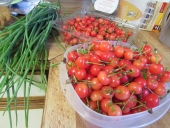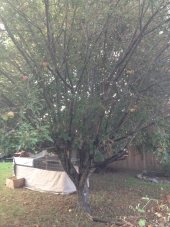
 10
10




Passionate advocate for living at a human scale and pace.
Help me grow the permaculture presence in Indiana https://permies.com/t/243107
Concise Guide to Permies' Publishing Standards: https://permies.com/wiki/220744
 9
9




 12
12




Striving to grow things as naturally, simply, and cheaply as possible! 
My YouTube channel
 9
9





 16
16




- Tim's Homestead Journal - Purchase a copy of Building a Better World in Your Backyard - Purchase 6 Decks of Permaculture Cards -
- Purchase 12x Decks of Permaculture Cards - Purchase a copy of the SKIP Book - Purchase 12x copies of Building a Better World in your Backyard
 11
11




"When the whole world is running towards a cliff, he who is running in the opposite direction appears to have lost his mind." C.S. Lewis
Visit https://themaineingredient.com for organic, premium dried culinary herbs that are grown, processed, and packaged in the USA.

 8
8




 15
15




Nicky & Dave
Founders of Permaculture Gardens and the Grow-it-Yourself Program
Check out our permaculture design app!
https://www.permaculturegardens.org/sage-app
 1
1




Nicky Schauder wrote:Hi all! We talked about an Apple Guild in particular in our recent workshop on guilds and our permaculture garden design app called SAGE.
Below is one option, though certainly not the definitive take on the subject.
I've also written more about guilds on https://www.permaculturegardens.org/permaculture-guilds
Passionate advocate for living at a human scale and pace.
Help me grow the permaculture presence in Indiana https://permies.com/t/243107
Concise Guide to Permies' Publishing Standards: https://permies.com/wiki/220744
 8
8




Creating sustainable life, beauty & food (with lots of kids and fun)
 13
13




 8
8




Om is where the heart is.
 16
16




This is all just my opinion based on a flawed memory

 16
16




Pete Podurgiel wrote:I took some advice and planted chives around my fruit trees .....can't say that I regret it.
 6
6




My tree nursery: https://mountaintimefarm.com/
 10
10





 5
5




Working toward a permaculture-strong retirement near sunny Sperling.
 9
9




 2
2




William Kellogg wrote:Morell mushrooms love to coexist with apple trees
JayGee
 3
3




Jim Garlits wrote:My budding permaculture paradise on 3/4 acre currently includes a line of fruit trees (apple, pear, peach, cherry) and I want to put plants underneath them to contribute to the soil conditions the trees need, get more food, and generally keep the mower away from the trees. The plants I'm asking about should be good for apple trees (Honeycrisp and Fuji), and I don't know if it matters...would the same plants do well underneath the others? Any real life experience you've had with doing this, I'd be so happy if you shared.
$10.00 is a donation. $1,000 is an investment, $1,000,000 is a purchase.
 3
3




champagne taste on a beer budget leads a gurl to be curious & resourceful. Celebrate what we are capable of when we put all prejudices about limitations aside.
 1
1




 2
2




 3
3





 2
2




 3
3




Best luck: satisfaction
Greatest curse, greed
 2
2




Jen Siegrist wrote:I plant garlic, strawberries, yarrow, artichokes and either baptisia (noxious to deer) or lupines as nitrogen fixers. The garlic helps control pests. The yarrow is great for deep accumulator, the strawberries are rapid spread ground cover, and the artichokes don't compete for nutrients.
Jen
$10.00 is a donation. $1,000 is an investment, $1,000,000 is a purchase.
 2
2




Our inability to change everything should not stop us from changing what we can.






 3
3




WARNING permaculture is highly addictive, it may cause life altering changes such as valuing people, community and resources, and promote respect, learning, support and kindness .
 4
4




 5
5




Erin Bouton wrote:Hi I know this is an old forum, new to gardening but I have 2 apple trees about 3 years old. This will be my first year doing more than some fruit trees and berry garden. I have a pretty standard size backyard (dwarf trees) we have a lawn so we dug out an area of grass for the trees, when talking companion planting. Do I plant chives or comfry in the dirt mound created by removing some of my grass? I hope im explaining this right, it's bare dirt around my trees, lawn everywhere else. Can I plant up to the base of my tree in that small circle area? Probably a stupid question but I don't want to harm my trees, trying to grow a bit of a victory garden so to speak to feed my family and friends. Thanks for any and all help!
 6
6




Best luck: satisfaction
Greatest curse, greed
 5
5




Mediterranean climate, hugel trenches, fabulous clay soil high in nutrients, self-watering containers with hugel layers, keyhole composting with low hugel raised beds, thick Back to Eden Wood chips mulch (distinguished from Bark chips), using as many native plants as possible....all drought tolerant.
 1
1




Cristo Balete wrote:I have been having a great time planting soy beans. They are hardy, verdant, attractive. They are up in a week and just take off after that. They fix nitrogen, bees love them. You can eat them, save some seeds, have them everywhere. Even the gophers seem to ignore them. When they are done I clip them off at ground level, compost the tops and leave the nitrogen-fixing roots in the soil to break down.
They keep my spirits up when other crises are happening.
$10.00 is a donation. $1,000 is an investment, $1,000,000 is a purchase.

|
I am not young enough to know everything. - Oscar Wilde This tiny ad thinks it knows more than Oscar:
The new permaculture playing cards kickstarter is now live!
https://www.kickstarter.com/projects/paulwheaton/garden-cards
|








